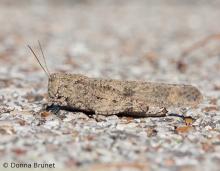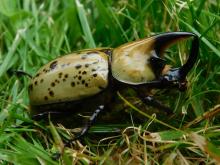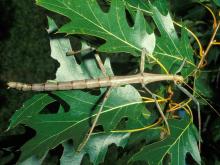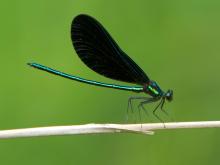Land Invertebrates
Media

Species Types
Scientific Name
Dissosteira carolina
Description
The Carolina grasshopper is frequently seen in dusty, open habitats like dirt roads and vacant lots. Its yellow-bordered, black hindwings make it look like a mourning cloak butterfly.
Media

Species Types
Scientific Name
About 28 species in North America
Description
Horntails look a lot like wasps but have a taillike spine that projects from the tip of the abdomen. Their cylindrical bodies also lack the narrow waist so common in wasps.
Media

Species Types
Scientific Name
Dynastes tityus
Description
The eastern Hercules beetle is a breathtaking animal. Like its Greek-hero namesake, it is big and strong. Males have horns; females do not. Hercules beetles are harmless to people.
Media

Species Types
Scientific Name
Megaphasma denticrus
Description
The giant walkingstick is the largest insect in North America, with females up to 7 inches long. The middle and hind legs have spines. Males have a single, large spine on each hind leg.
Media

Species Types
Scientific Name
Diapheromera femorata
Description
The northern walkingstick is Missouri's most common species of walkingstick. It is perfectly camouflaged for a life in trees and shrubs. They not only look like twigs but also sway their bodies to mimic the motion of branches in a breeze.
Media

Species Types
Scientific Name
About 20 species in North America north of Mexico
Description
Scoliid wasps are a family of beetle hunters. Large, rather hairy wasps, some are handsomely colored. The female digs in soil, finds a scarab beetle grub, and lays an egg on it.
Media

Species Types
Scientific Name
Glenurus gratus
Description
The antlion known to science as Glenurus gratus ought to be called the pleasing antlion, but it has no formal common name.
Media

Species Types
Scientific Name
Meloe spp.
Description
Blister beetles in the genus Meloe are called oil beetles because of a yellowish oil they excrete from their joints when squeezed or distressed. This oil contains cantharidin, an irritating chemical that can cause blistering in many people.
Media

Species Types
Scientific Name
Calopteryx maculata
Description
The ebony jewelwing is a beautiful iridescent green or turquoise damselfly with large black wings. It flutters around streams in wooded areas.
Media

Species Types
Scientific Name
Libellula luctuosa
Description
The widow skimmer has distinctive dark wing markings that seem like mourning garb. Mature males have white areas in the center of their wings, beside the dark patches, while females and immature males lack the white patches.
See Also



Media

Species Types
Scientific Name
Cisseps fulvicollis
Description
The yellow-collared scape moth is more often “orange-collared.” And whether you think it looks more like a firefly or a wasp, it’s still a moth!
Media

Species Types
Scientific Name
Nearly 150 species in North America north of Mexico
Description
Slim, delicate plume moths are instantly recognizable by their T-shaped silhouette, long legs, and muted shades of tan and brown. It can be hard to separate the various species.
Media

Species Types
Scientific Name
Pyrrharctia isabella
Description
Not many people know the adult Isabella tiger moth when they see one, but we’re all acquainted with its caterpillar, the woolly worm, or woolly bear.
About Land Invertebrates in Missouri
Invertebrates are animals without backbones, including earthworms, slugs, snails, and arthropods. Arthropods—invertebrates with “jointed legs” — are a group of invertebrates that includes crayfish, shrimp, millipedes, centipedes, mites, spiders, and insects. There may be as many as 10 million species of insects alive on earth today, and they probably constitute more than 90 percent all animal species.





















